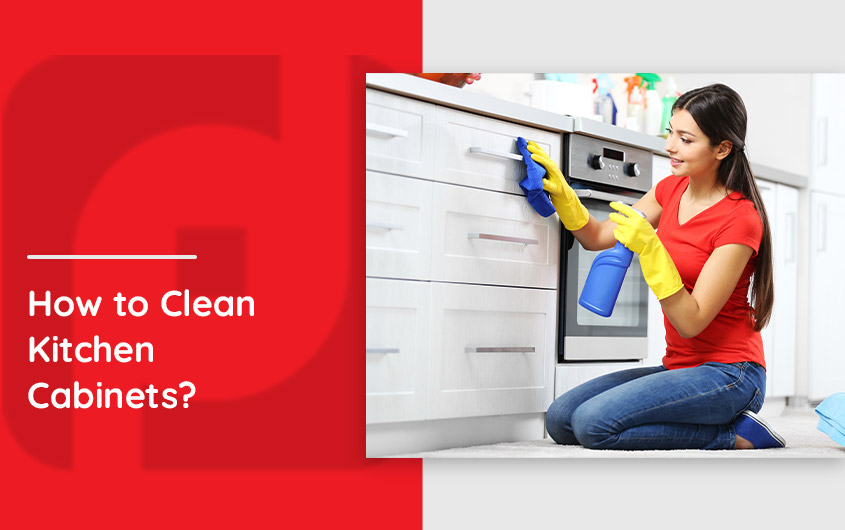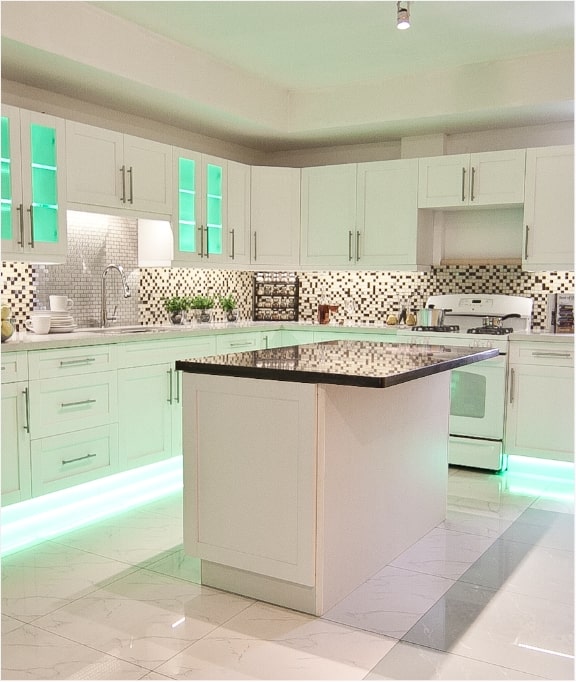The cabinets in your kitchen are an important part of your home interior. They need timely attention. If left ignored they start gathering dust, dirt, grease, grime, and other residues. They are not just tough to remove. But they give your kitchen an ugly, unclean look as well. Besides, dirty kitchen cabinets can pose serious health hazards too.
Here are some simple, regularly adopted keys as to how to clean kitchen cabinets and keep them tidy.
How Do You Deep Clean Kitchen Cabinets?
The cabinets in your kitchen need deep cleaning every few months. Here are the essential steps to perform this comprehensive exercise.
Make the cleaning solution ready
The majority of kitchen cabinets, no matter whether they are made from wood, metal, laminate, glass, etc. can be thoroughly cleaned with liquid dish soap mixed with warm water. Also, you can use an all-purpose commercial cleaner. They are mild, simple solutions capable of removing dust, grime, grease, food smudges, and many more spoilers.
Take on a top to down approach
Always clean the cabinets by starting at the top and working your way down. Spray the cleaning solution directly on the surface and wipe it down with a clean, soft cloth. Keep in mind to clean the sides and edges of the cabinets as well.
Rub off the cleaner completely
Make sure you rinse the surface with one more clean cloth to the fullest extent. Next, dry the surface with another cloth. Ensure no water sits on the cabinets as it can lead to damage or discoloration.
Clean the glass portions or mirror add-ons
Use a paper towel or lint-free cloth to clean glass parts and mirror insets by spraying glass cleaner onto them. Avoid spraying directly on the glass surface as the cleaner may penetrate inside any woodwork and other different parts thereby resulting in discoloration.
Clean knobs, handles or pulls
To attend to metal hardware such as handles, knobs, trims, use a toothbrush dipped in a solution containing warm water and vinegar and scrub the surfaces and their crevices.
Do away with an adamant grease accumulation
Grease can be removed from the surface of kitchen cabinets with the help of an orange oil cleaner. Let it settle on the greased surface and deep in. Keep it undisturbed for 2 to 4 minutes. This process may need a few repetitions. You can also use a magic eraser or a paste made by mixing baking soda in water. Softly scrub the greased surface to remove the thick oily substance.
Get each of the cabinets emptied
Vacate all the kitchen cabinets by removing their contents, any damaged or discolored lining on shelves. You may find lots of residues and crumbs in the interior. The best way to remove them is through the use of a vacuum cleaner.
Wash the cabinet interiors
Use a mild detergent and warm water to pull off this task.
Rinse the cabinet interiors
Use a damp, clean cloth for the rinsing purpose. Use an extra cloth to wipe dry and see to it no residual water that may cause damage to the surface of the cabinets is left behind.
Clean up the contents in the cabinets
Use the same solution of dish soap and warm water to wipe clean dirty cans or containers with a damp cloth. Thoroughly dry the items before placing them back in the cabinets.
Tips For Cleaning Different Cabinet Types
Painted cabinets
They are almost integral to kitchens. Painted cabinets add color and vibrancy to your kitchen even without a major overhaul. But, painted kitchen cabinets need maintenance to look even better.
Tips for cleaning painted cabinets
Abide by the tips given below for cleaning painted cabinets.
- You can make an easy, affordable cleaner by mixing water and baking soda in the ratio of 1:2. The product is very effective in removing spots. Spread a little amount of the paste on the stain. Allow a few minutes for the paste to sink into the stain before wiping the area off. Rub out any residue with the help of a soft, clean cloth.
- How to remove grime and grease from kitchen cabinets? You can use a cloth moistened with watered-down ammonia and apply it to the surface. Wipe off the cabinet gently. See to it the stain has gone away or become less obvious.
- Extensive use of painted cabinets over time can lead to the paint wearing off or getting discolored. So, think of getting your cabinets repainted.
Wooden cabinets
At times, it may indeed be difficult to figure out the most effective way of cleaning wooden kitchen cabinets. This is because they are available in several diverse finishes. They may also be made from various types of seals.
Even though a few seals have more tolerance than the others, still, as a precautionary measure, it is recommended to use mild cleaners to make wooden cabinets neat and tidy.
Tips for cleaning wooden cabinets
Adhere to the following tips and learn the method of cleaning wooden cabinets.
- You can use soap oil cleaner like Murphy® Oil Soap. It is a neutral detergent that not only cleans the cabinet surfaces but also adds more shine. Because of the non-abrasive nature of the solution, it offers a fresh, new look to your cabinets without causing any harm.
- Make sure you use damp, unsoaked cloth materials to clean wooden kitchen cabinets. This is because if the wood is subject to excessive liquid saturation, its condition may deteriorate.
- You can make use of a dry cloth made of microfiber material to rub up and polish the cabinets. Use grains of wood to wipe down clean.
- Keep a watch on the condition of the wooden cabinets in areas that are highly exposed to moisture. Observe the area just above the gas stove. The cabinets in proximity will regularly need maximum care as they are not protected against steam or from condensation. You may think of applying an extra coating of sealant for these unguarded cabinets.
Laminate cabinets
The laminate acts satisfactorily when you wipe it with nearly all types of cleaners. It calls for little maintenance other than wipe-offs once a week.
Tips for cleaning laminate cabinets
Stick to the tips given below for cleaning laminate cabinets.
- Use diluted vinegar or a commonly available cleaner good for a great many uses. Dry the laminate surface with a soft, clean cloth from top to bottom.
- Do away with stains with the same paste you made by mixing water and baking soda to clean the painted cabinets. Apply the paste directly to the stain. Allow some time for the paste to settle in and do its work. Then wipe off the paste with a clean cloth. You will find the stains gone too.
- Steer clear of using cleaning pads made of abrasive materials. They can lead to scratches on the surface of kitchen cabinets and cause irreparable damage. To get rid of scuff marks especially on the lower cabinets, make good use of a gentle eraser.
Glass cabinets
Every so often, glass cabinets are fused with a different material, for example, laminate or wood to create panels on their doors. Even though glass can be easily cleaned, make certain you select a cleaning agent that causes no harm to the other adjoining cabinet material.
Tips for cleaning glass cabinets
Comply with the following tips for cleaning glass cabinets.
- With the help of a soft, polishing cloth and glass cleaner, remove traces of fingerprints or other marks from the cabinet panes.
- Do the cleaning inside as well by opening the cabinet doors. Still, you may need to get rid of individual marks developed on the front of the cabinet. However, this technique helps you wipe off the whole pane in a single swipe.
- Stay away from oil-based cleaners when it comes to attending to the material by the side of the cabinets. They can leave behind residual patches and stains on the glass that may be difficult to ward off.
Tips for Long-Term Kitchen Cabinet Cleaning
Carry out a regular dusting of your kitchen cabinets. This should be done every alternate week. Use a standard duster, rag, or soft cloth to dust. This activity will reduce the need to do a frequent deeper cleaning.
Any spills or scatters on the cabinets should be immediately removed with a sponge or damp cloth. Make sure the substance does not stay longer on the body of the cabinets and affect them. This will decrease the possibility of the formation of stains that may be too obstinate to be removed later.
Sometimes you may have cabinets positioned close to a self-cleaning oven or chimney. These cabinets are more at risk to be damaged because of the constant, intense heat that may dissipate from a malfunctioning heat gasket or sealant.
To stave this off, remove the shutters and drawers of all the cabinets that surround the oven if possible. This will facilitate an effective cleaning operation.
Appliances that generate heat should be kept away from kitchen cabinets. These appliances include a rice cooker, toaster, coffee maker, etc. When the material with which cabinet surfaces are made is exposed to additional heat and moisture it can get damaged.
Conclusion
Hopefully, you have read through the various steps and tips to make sure your kitchen cabinets remain clean and visually appealing. Still, if you are in a fix, do not shy away from consulting the manual from your cabinet manufacturer or talking to a cabinet cleanliness expert.








